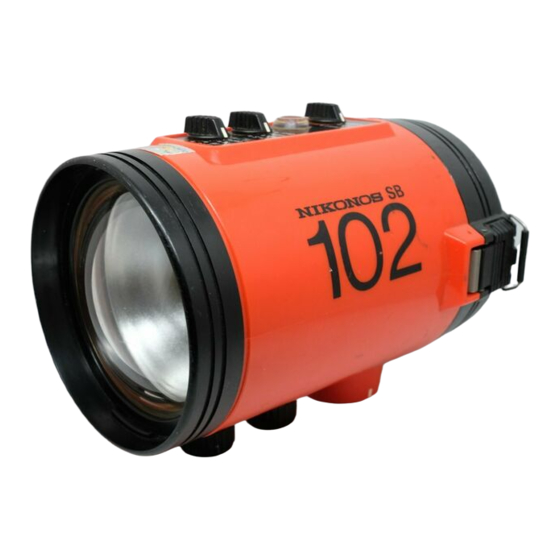Nikon SB-102 os Gebruiksaanwijzing - Pagina 26
Blader online of download pdf Gebruiksaanwijzing voor {categorie_naam} Nikon SB-102 os. Nikon SB-102 os 36 pagina's. Speedlight

CONTROLS IN DETAIL-continued
_ _ _ _
Example 3:
Shooting a subject
on land
at
8m (26.2ft)
without using
the wide-flash
adapter
while using ASAIISO 100
film
and
"MFULL":
The GN for
" MFULL"
at
ASAIISO 100
on land is
32
(from the chart below). Divide the GN of
32
by the flash-to-subject distance of 8m to get the
correct
aperture,
f/4. Because water absorbs a great
deal of
light,
however,
you cannot use
the
same GN
underwater as on land or your shot will be
underexposed.
Instead,
multiply the on-land GN by 1/2 to 1/3 for
under-
water
photography.
(The
underwater GNs shown
in
the
following chart are 1/2 of the corresponding on-land
GNs.)
Guide Numbers in the Manual Mode
•
The
values in
parentheses
are when the
Wide-Flash
Adaptor
SW-102 is
being used
.
•
The full
amount of light is
emitted
when the shooting mode
selector
is
at
"MFULL
" and, even if
not
liynchronized,
at
"AUTO."
TTL Exposure Compensation
When
using
TTL
automatic flash control with the
Nikonos-V camera, you can use its
ASAIISO
film
speed
dial to make an exposure compensation for the
shooting
situation or to create
intentionally
over- or underexposed
photos.
The relationship between the exposure compensation
value and
ASAIISO
film speed
dial
setting is shown in
the following chart:
The
useable aperture range for
TTL
automatic flash
photography changes according to the exposure com-
pensation value being
used.
Before using the exposure
calculation dial to determine the useable aperture
range,
align the correct shooting situation mark with
new
(compensation) setting on the
ASAIISO
film speed
scale.
26
Exposure Compensation
When the Nikonos-V is used with the SB-102 in
the
TTL
or non-TTL flash
mode,
exposure
compensation
is
re-
quired for over- or underexposing the picture to match
subject or shooting conditions. Each procedure
is
dif-
ferent
,
so
read
the following instructions
carefully
be-
fore
shooting.
In addition
,
if you photograph
a subject
with
very
high
reflectivity,
such as a mirror or metallic
surface
,
under-
exposure is almost certain to
occur.
To prevent
this,
use
manual flash control.
For example
,
to make
a
+
2 exposure
compensation
when using ASAIISO 100 film
,
reset the
ASAIISO
film
speed scale
to
ASAIISO
25, then
read
the modified
shooting distance from the
dial.
·
Positive
(+)
exposure
compensation cannot be made at some film
speeds, and
negative
(-) exposure compensation cannot
be
made
at
other
film
speeds.
In these
cases,
make the necessary compensation
in
the non-TTL automatic mode
(see
page
24)
or
use
one of
the manual
I/ashmodes.
•
When you finish making the exposure
compensation,
be
sure
to reset
the ASAIISO film speed dial on the Nikonos-V and the ASAIISO film
speed scale
on the
speedlight.
